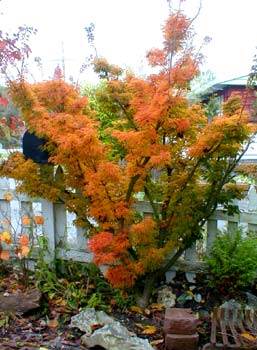
Do Street Lamps & Security Lights
Harm Plants by Being On All Night?
"Was there a Garden or was the Garden a dream?"
-Jorge Luis Borges
(1899-1986)
(1899-1986)
"The three Ps" of gardening with light are "photosynthesis, phototropism, & photoperiodism." These are respectively 1) nutrition through light; 2) mobility of plants due to light (literally following the sun hourly, or direction of growth over time as directed by light), & 3) seasonal awareness through light (when to bloom, when to drop leaves, etc).
All the Three Ps can be thrown out of wack by artificial lighting, but most especially photoperiodism is mucked up by bright street lamps, ornamental garden lamps, or security lights that stay on all night.
Plants' capacity to judge the seasons by the number of hours of light daily experienced is the "photoperiodism" component of the Three Ps. It is why some plants know to bloom in June & others in July — even slight changes trigger specific species behavior, as there are survival reasons for plants to not all be competing for the same pollinators at the same time.
Obviously not all plants are equally sensitive & some will adapt to conditions totally different from what they would've experienced in nature. But overall, seasonal light exposure that matches plant expectation is essential to full garden health. Being lit all night, & especially so for autumn bloomers, can stop some plants from ever blooming at all, because late-blooming plants wait & wait & wait in vain for the days to get shorter, & they may not bloom if they can't tell it's autumn.
Many summer bloomers wait until it's closest to 12 hours of daylight to commence bloom, then become quiescent when they detect via shortened light hours winter's on the way. Summer bloomers may well try to bloom out of season under artificial lighting, at the very least freezing off their buds & at worst killing the plants. Flowers that would have been die-back perennials will not die back in preparation for winter, thus are killed by frosts. Pretty much all plants should be preparing themselves for winter, & to have their timing thrown off by night-time lighting puts them at risk of winter desication.
Trees with branches around street lights can remain in full leaf in winter on the warmed & lit branches. That one branch will be continuously trying to trigger spring activity from the roots below, to varying degrees of success, not usually harmful but it can be an added stress factor on a tree's susceptibility to winter conditions or to later insect attack or disease. Trees will also change their direction of growth around street lamps (phototropism).
A very few particularly sensitive-to-light-hours plants do poorly with afternoon sun but excellent with morning sun (or vise versa) not because of the heat difference but because they are counting hours of light & they get confused as to the season if deep morning shade makes them believe the days are starting late.
On the other hand strategically placed garden lights as with garden heat coils can be used to keep subtropicals (or "patio tropicals") from winter-burning, if left outside year round. Equatorial species are not counting seasonal light hours, or may actually need their days extended.
Security lights around the house should be on motion detectors, not merely to save electricity but also to keep from lighting the garden inappropriately. There's not much can be done about street lights, though I know one chap who bought a high-powered slingshot to take care of even that.
Photoperiodism is not unique to the plant world. Newts & salamanders also assess breeding seasons by day lengths, so that without regard for which week it is that winter cold gives way to warm spring rain, newts will know by light rather than by weather pattern that it is time for all their species to arise simultaneously, even if it means migrating over snow when winter lasts later than usual, to get to their breeding ponds all on the same week to have an orgy. Breeding them in captivity requires careful planning to take into consideration their photoperiodic sensitivity, & they can even be intentionally induced to breed out of season. Shorten their days, they think it's winter; lengthen their days & flood their enclosure, the males get horny & the females' eggs develop & their cloacas swell.
Even humans are effected by the principle of photoperiodism. We are meant to be lazier in winter, & the traditions of "spring house-cleaning" & "June wedding" are more connected to biology than our sense of ourselves as apart from nature likes to admit. Lengthening spring days do turn us magically into eager beavers & rutting rabbits. "Winter blues" are not so much the fault of gloomy weather but because we use artificial lighting to defeat our own biology, which has chemical repercussions for emotional states.
A gardening chum pointed out another problem with 24-hour lighting over plants, in that it may interfere with nocturnal pollination, offering the example of the hornworm moth, a night-time pollinator for gourds, which can become disoriented by night lighting.
In all, our gardens, & all of nature, are extensions of ourselves, or more precisely we are their extensions. Flora & fauna, not excluding ourselves, share this biological need to register the passing of seasons by an inate photoperiodic awareness. It's one more reason that gardening is a healthful activity for humans, as gardens help in this required awareness of seasons.
Thanks to Olin for pointing out the effect
of nightlighting on nocturnal pollinators.